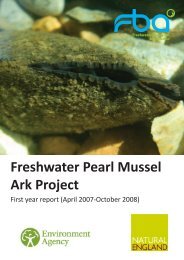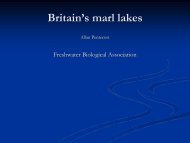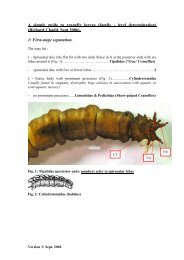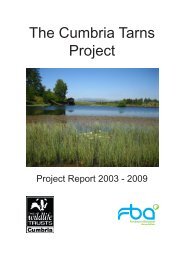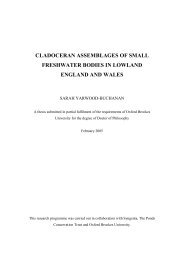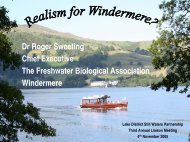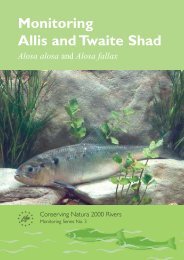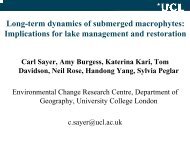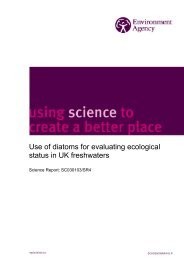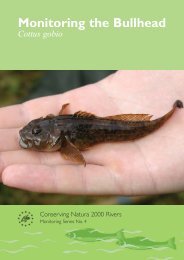Groundwater HIA post edit - FreshwaterLife
Groundwater HIA post edit - FreshwaterLife
Groundwater HIA post edit - FreshwaterLife
You also want an ePaper? Increase the reach of your titles
YUMPU automatically turns print PDFs into web optimized ePapers that Google loves.
• Monitoring associated with <strong>HIA</strong> is deliberately not prescriptive, because like<br />
the <strong>HIA</strong> itself, it should be based on risk, and should be appropriate to each<br />
case.<br />
• It will be seen in Section 5 that the monitoring should be focussed on the<br />
water features that have been identified during the <strong>HIA</strong> as being<br />
susceptible to flow and drawdown impacts. This is a somewhat similar<br />
approach to the source-pathway-receptor concept often used in water<br />
quality, contaminated land and landfill studies. The abstraction is<br />
equivalent to the source, the sensitive water feature is the receptor, and the<br />
pathway is the aquifer in between.<br />
• Monitoring the long-term groundwater level changes in a borehole that is<br />
not too close to be directly affected by individual abstractions provides a<br />
very useful indication of the 'health' of the water balance in the aquifer. In<br />
other words, if the outflows are consistently greater than the inflows, water<br />
will be taken from storage, and this manifests itself as an overall decline in<br />
groundwater levels. The Environment Agency maintains a network of such<br />
reference boreholes.<br />
4.3 After each tier<br />
4.3.1 Consultation<br />
Assuming that you have reached the end of a Tier 1 investigation (which may have<br />
involved several iterations), it is recommended that you consult the Environment<br />
Agency before proceeding any further, for the following reasons:<br />
i. If any of the water features that have been identified as being impacted (or<br />
potentially impacted) is a SSSI, Special Area of Conservation (SAC),<br />
Special Protection Area (SPA), or Ramsar site, then the Environment<br />
Agency will need to trigger the relevant consultation process with Natural<br />
England or CCW.<br />
ii. It may be that agreement can be reached with the Environment Agency<br />
after a Tier 1 investigation, without having to proceed any further (even if it<br />
was initially thought that a Tier 2 or 3 investigation might be necessary).<br />
This is likely to be because there is no significant impact, or because the<br />
impact is obvious and can be easily mitigated, or because the impact<br />
cannot be mitigated and is unacceptable.<br />
iii. It is the Environment Agency's role to assess the cumulative impacts of all<br />
abstractions in a certain groundwater management unit or groundwater<br />
body, and should it be necessary to continue with the <strong>HIA</strong> process beyond<br />
Tier 1, the Environment Agency may be able to supply you with missing<br />
data, or advise you on aspects that need a closer look.<br />
iv. The <strong>HIA</strong> methodology is intended to be flexible and based on risk, so<br />
following on from the previous point, it may be that the Environment Agency<br />
just asks for a certain aspect to be looked at more closely, without having to<br />
go through a full Tier 2 investigation.<br />
Note that the same comments apply at the end of Tier 2, perhaps even more so, as the<br />
costs associated with a Tier 3 numerical groundwater model can be significant.<br />
42 Science Report – Hydrogeological impact appraisal for groundwater abstractions




